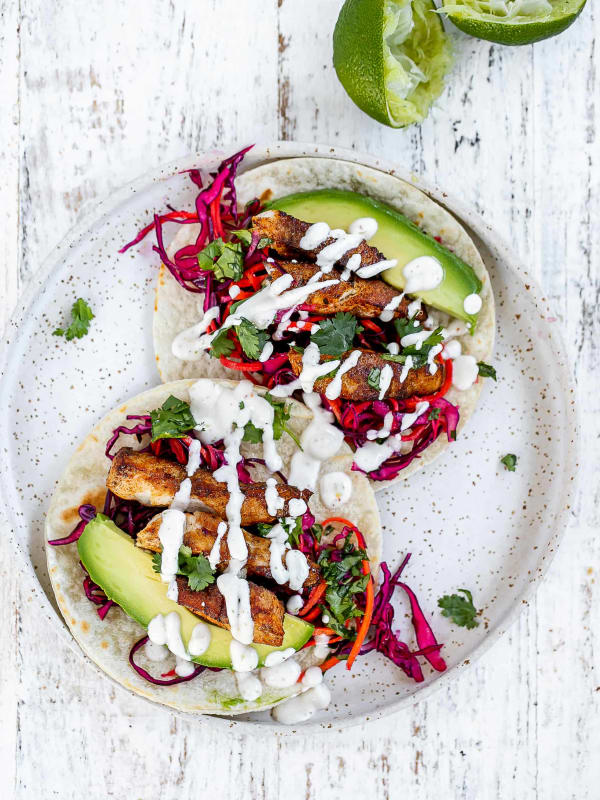The Rily Guide to the Low-Histamine Diet

The Rily Guide to the Low-Histamine Diet
Learn how a low-histamine diet may help reduce symptoms like headaches, skin issues, and digestive discomfort.
If you've been searching for answers to unexplained headaches, skin issues, digestive discomfort, or even anxiety, you might have stumbled across the term "histamine intolerance." Understanding and managing this condition's many seemingly unrelated symptoms can feel overwhelming.
Fortunately, a properly implemented low-histamine diet can be an absolute game-changer for identifying triggers and reclaiming your health on multiple levels at once; it might be the one thing that takes care of a lot of things.
This comprehensive and user-friendly guide offers everything you need for all things histamine. In it, we explore the role of histamine in the body, the causes and symptoms of intolerance, and practical steps to implement a low-histamine diet. It includes complete lists of foods to avoid, alternative suggestions, and other science-backed strategies for success.

What is Histamine?
Histamine is a chemical compound produced by the immune system, specifically by mast cells and white blood cells called basophils. It's vital for several bodily functions, including:
Immune response: Histamine is produced in response to perceived incoming threats, such as allergens or infections, and helps fight them by causing inflammation and increasing blood flow.
Gastric acid production: It plays an important role in digestion by triggering the release of stomach acid to break down the food we eat.
Brain function: Histamine acts as a neurotransmitter, promoting alertness and regulating sleep-wake cycles.
Our bodies make histamine for very good reasons, and it doesn't normally cause trouble. However, when histamine levels become excessive- due to dietary intake, reduced enzyme activity, or overactive immune cells- it can cause a variety of symptoms.
Symptoms of Histamine Intolerance
Histamine intolerance may be under-diagnosed because its symptoms can (understandably) appear similar to allergic reactions. The waters are further muddied by the fact that there are histamine receptors all over the body, creating a very broad range of possible symptoms that can include:
Digestive issues: Bloating, nausea, diarrhea, or constipation. Neurological effects: Headaches, anxiety, or sleep disturbances. Cardiovascular reactions: Increased heart rate or low blood pressure. Respiratory symptoms: Nasal congestion, wheezing, or asthma-like reactions. Menstrual irregularities: Painful or irregular periods. Skin problems: Rashes, hives, eczema, or flushing.
What is Histamine Intolerance, and Why Does it Happen?
Histamine intolerance occurs when the balance between histamine accumulation and clearance is disrupted, leading to a buildup of more histamine than the body can handle.
This can happen for several main reasons:
Enzyme deficiency: Diamine oxidase (DAO) and histamine-N-methyltransferase (HNMT) are enzymes chiefly responsible for breaking down histamine.
The enzyme HNMT is present in cells all over the body and its function can be compromised by genetic variations called 'single nucleotide polymorphisms' (SNPs). This could explain why some people are naturally predisposed to histamine trouble.
But the more important of the two is definitely DAO. This enzyme is a key gut defender, where it acts as the body's main defender against excess histamine. It lives primarily in the villi, the finger-like extrusions in the small intestine. This is important because it highlights a major root cause of histamine intolerance: when the lining of the gut is damaged, the ability to produce DAO to clear away histamine is directly affected.
The small intestine is also where histamine- whether from gut bacteria, from food, or from the body's own production- is absorbed into general circulation. Thus, taking care of gut integrity and watching out for increased intestinal permeability (aka leaky gut) is of paramount importance for anyone with histamine issues.
Microbiome Imbalances: A healthy microbiome is critical for keeping histamine levels in balance. Several species of opportunistic gut bugs, such as those in the Morganella and Klebsiella families, can increase circulating histamine while reducing the body's ability to metabolize it.
Other beneficial strains, including several in the Lactobacillus and Bifido families, can degrade histamine and clear it away, effectively keeping it in check.
Medication: Certain drugs, like Aspirin, NSAIDs, antihypertensives, narcotics, diuretics, antidepressants, antibiotics, and muscle relaxants can inhibit DAO function, leading to histamine buildup and sensitivity to high-histamine foods.
It's been estimated that 20 per cent of Europeans regularly take DAO-inhibiting drugs, and this number may be even higher in North America. Interestingly, even high doses of vitamin C and thiamine (vitamin B1) can impair healthy histamine metabolism.
How Can a Low-Histamine Diet Help?
A low-histamine diet reduces your intake of:

Foods that are naturally rich in histamine. Examples include all fermented foods, such as sauerkraut, kimchi, and miso, aged cheeses, cured meats, smoked or canned fish, and anything that contains vinegar.
Foods that trigger the body's histamine release. Such foods are also referred to as 'histamine liberators.' Examples include cocoa, tomatoes, avocados, strawberry, and pineapple.
Foods that inhibit DAO enzyme activity. Examples include alcohol (especially red wine), caffeine, and some citrus fruits like grapefruit and lemon.
While it's impossible to eliminate histamine entirely, and we would not want to, for all of its essential functions, lowering dietary exposure can majorly reduce symptoms. The low-histamine diet has been referred to as the gold standard, first-line approach for addressing histamine intolerance. Some research has revealed that it can reduce symptoms for almost 90 per cent of people.
Here's a breakdown of high-histamine foods and low-histamine swaps:
Veggies to Avoid: Tomatoes Spinach Eggplant Avocados Olives
Low-Histamine Alternatives: Zucchini, cucumbers, and carrots are great swaps that won't spike histamine levels. Sweet potatoes are another nutritious option. In general, it's best to focus on fresh, non-nightshade veggies for the best results.
Fruits to Avoid: Citrus fruits (oranges, lemons, limes), tropical fruits (pineapple, guava, papaya, kiwi), bananas (especially ripe ones), strawberries, dried fruits (apricots, figs, and dates)
Low-Histamine Alternatives: Apples and pears are excellent low-histamine fruits. Watermelon and blueberries are other safe bets, bringing sweetness and fibre into the picture without the histamine risks.
Fermented Foods to Avoid: Cheese (especially aged varieties like Parmesan, Pecorino, or blue cheese), yogurt and kefir (even plain), sauerkraut and kimchi, vinegar (of any kind) and anything pickled, alcohol (beer, champagne, and especially red wine)
Low-Histamine Alternatives: Fresh cheeses like mozzarella or ricotta can sometimes be tolerated in moderation. Instead of fermented sides, try fresh herbs like parsley or cilantro to add flavour. For drinks, sparkling water with a splash of fresh juice can mimic the fizzy tang of fermented drinks.
Meats and Fish to Avoid: Cured, smoked, and processed meats (bacon, salami, ham), canned, marinated, or smoked fish (tuna, sardines, and mackerel), leftover meat dishes, bone broth of all types, organ meats
Low-Histamine Alternatives: Stick to freshly cooked chicken, turkey, or lamb, and eat it the same day it's prepared. Fresh, white fish like cod, trout, or sole are also good options if eaten immediately. Most people tolerate eggs - especially the yolks - quite well.
Nuts and Seeds to Avoid: Walnuts, cashews, peanuts
Low-Histamine Alternatives: Pumpkin seeds and sunflower seeds are histamine-friendly choices. Macadamia nuts and hemp hearts are also great low-histamine sources of healthy fats, minerals, and protein.
Beverages to Avoid: Coffee, black tea, green tea, and mate, kombucha, alcohol
Low-Histamine Alternatives: Herbal teas like chamomile, peppermint, or rooibos are excellent substitutes. For coffee lovers, decaf may be tolerated in small amounts. Fresh coconut water or plain water with mint can keep you hydrated and histamine-safe.
Other Things to Avoid: Soy sauce, mustard, ketchup, hot peppers and spicy sauces, additives, flavours, and artificial colours, cocoa, chocolate, and carob, MSG, legumes (tofu, tempeh, beans, chickpeas, and lentils), wheat germ, yeast extract, and seitan

More Tips for Success
Prioritize freshness: Histamine levels increase as food ages- even if it was low-histamine when it was first prepared. Avoid leftovers and choose fresh, minimally processed ingredients. This is especially important for proteins like meat and fish.
Freeze leftovers immediately: If you must store meals, freezing them promptly minimizes histamine accumulation.
Manage your stress: Stress hormones are hard on the lining of the gut, which as we've established, can only make histamine balance harder.
Cook with intention: Boiling often results in lower histamine content than frying or grilling.
Consider supplementing DAO: Enzyme supplements may help if your body is struggling to break down histamine.
Heal your gut: Addressing underlying gut issues, such as leaky gut, can improve DAO production and histamine tolerance.
Consider cutting out gluten: While gluten won't appear on high histamine lists, it is notoriously hard on the gut membrane because it isn't. It can't be overstated: a healthy gut barrier is the best defence against histamine intolerance.
Can Histamine Intolerance Be Recovered From?
Yes! While managing histamine levels is crucial for immediate symptom relief, addressing the root causes- like gut health or enzyme deficiencies- can lead to sustained long-term improvement. Working with a functional healthcare provider to develop a personalized plan is always a good idea.
Remember that it's only temporary, and keep your eyes on the prize: a low-histamine diet can be life-changing for those struggling with histamine intolerance. By focusing on fresh, low-histamine foods and identifying individual triggers, you can quickly reduce symptoms, improve your overall well-being, and pave the way for deeper healing and a lifetime of histamine resilience.
Burkhart, A. (2024, November 26). The low histamine diet: What is it and does it work?. Amy Burkhart, MD, RD. https://theceliacmd.com/the-low-histamine-diet-what-is-it-and-does-it-work/
Cheang, Y. (2024, August 13). Low histamine diet 101 + recipes & guidebook. EA Stewart, The Spicy RD. https://www.eastewart.com/nutrition-tips/low-histamine-diet-recipes/
Cleveland Clinic. (2024, November 25). A quick introduction to the low histamine diet. Cleveland Clinic. https://health.clevelandclinic.org/low-histamine-diet
Comas-Basté, O., Sánchez-Pérez, S., Veciana-Nogués, M. T., Latorre-Moratalla, M., & Vidal-Carou, M. D. C. (2020). Histamine Intolerance: The Current State of the Art. Biomolecules, 10(8), 1181. https://doi.org/10.3390/biom10081181
Dev, S., Mizuguchi, H., Das, A. K., Matsushita, C., Maeyama, K., Umehara, H., Ohtoshi, T., Kojima, J., Nishida, K., Takahashi, K., & Fukui, H. (2008). Suppression of histamine signaling by probiotic Lac-B: a possible mechanism of its anti-allergic effect. Journal of pharmacological sciences, 107(2), 159–166. https://doi.org/10.1254/jphs.08028fp
The Food List. Histamine Intolerance. (n.d.). https://www.histamineintolerance.org.uk/about/the-food-diary/the-food-list/ Kung, H. F., Lee, Y. C., Huang, Y. L., Huang, Y. R., Su, Y. C., & Tsai, Y. H. (2017). Degradation of Histamine by Lactobacillus plantarum Isolated from Miso Products. Journal of food protection, 80(10), 1682–1688. https://doi.org/10.4315/0362-028X.JFP-17-135
Low histamine diet. Physical Nutrition. (2022, August 1). https://www.physicalnutrition.com.au/low-histamine-diet/
Montoya, C. (2024, October 17). Your essential guide to the low histamine diet. Arthritis Dietitian. https://www.arthritisdietitian.com/post/your-essential-guide-to-the-low-histamine-diet-arthritis-dietitian
Sattler, J., Hesterberg, R., Lorenz, W., Schmidt, U., Crombach, M., & Stahlknecht, C. D. (1985). Inhibition of human and canine diamine oxidase by drugs used in an intensive care unit: relevance for clinical side effects?. Agents and actions, 16(3-4), 91–94. https://doi.org/10.1007/BF01983109
Schnedl, W. J., & Enko, D. (2021). Histamine Intolerance Originates in the Gut. Nutrients, 13(4), 1262. https://doi.org/10.3390/nu13041262
Schnedl, W. J., Lackner, S., Enko, D., Schenk, M., Holasek, S. J., & Mangge, H. (2019). Evaluation of symptoms and symptom combinations in histamine intolerance. Intestinal research, 17(3), 427–433. https://doi.org/10.5217/ir.2018.00152
Sighi-leaflet histamine elimination diet. (n.d.). https://www.histaminintoleranz.ch/downloads/SIGHI-Leaflet_HistamineEliminationDiet.pdf
Simpson, A. (2024, October 22). 4-week low histamine diet plan PDF and comprehensive histamine intolerance guide. NUTRITION RESOLUTION. https://nutritionresolution.com/4-week-low-histamine-diet-plan-pdf-and-comprehensive-histamine-intolerance-guide/





